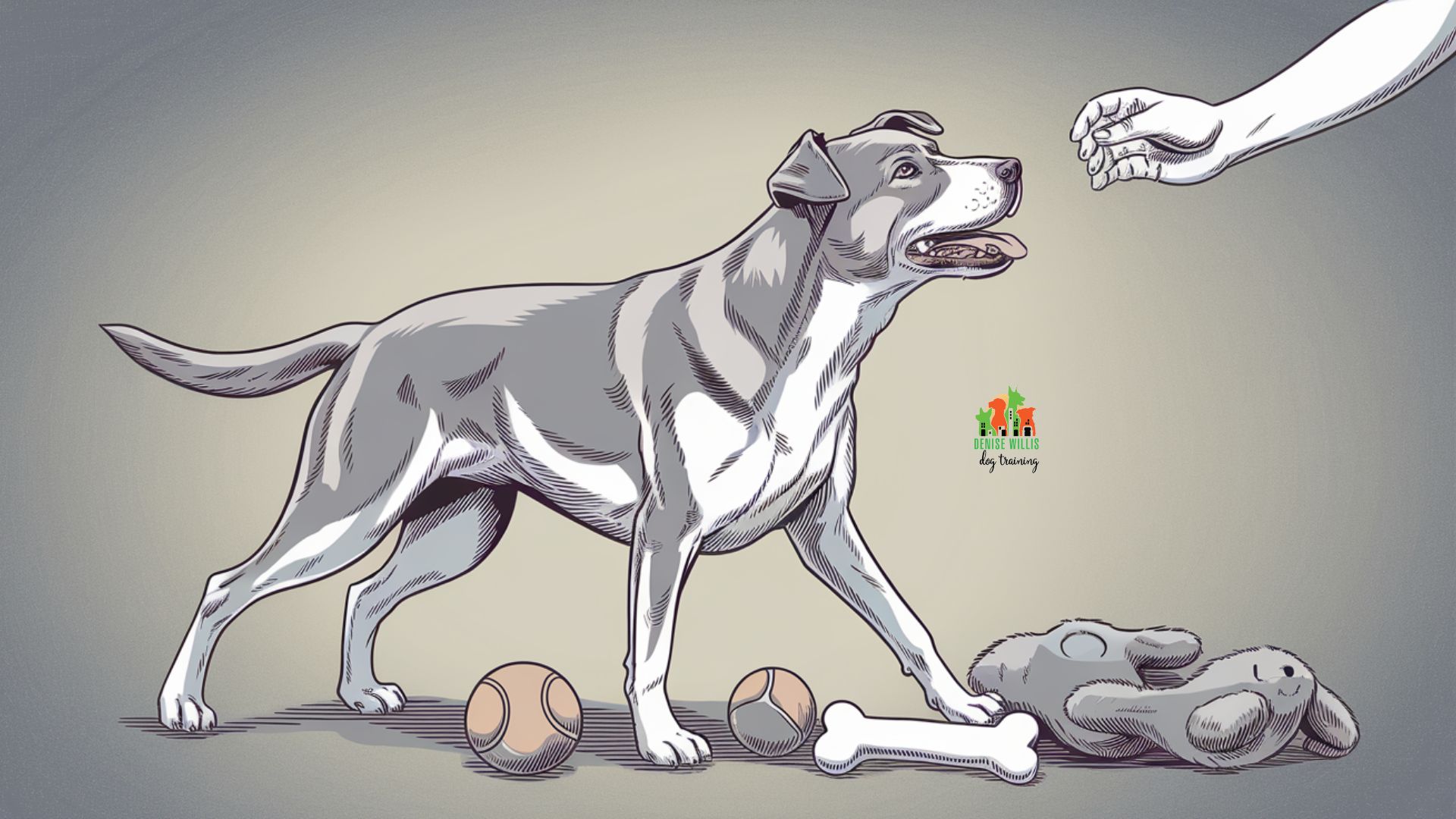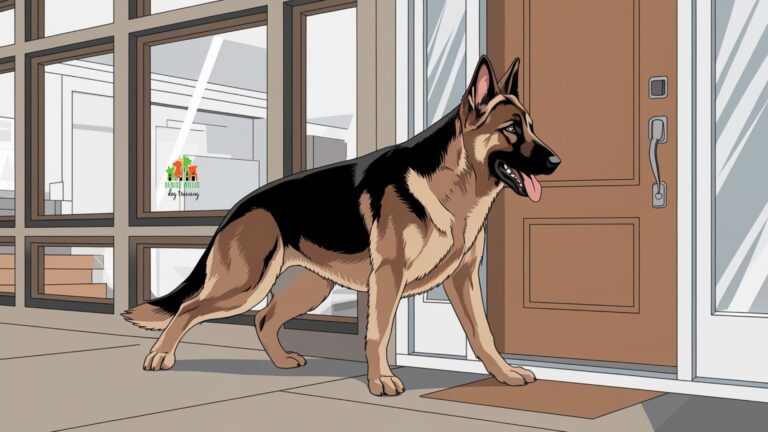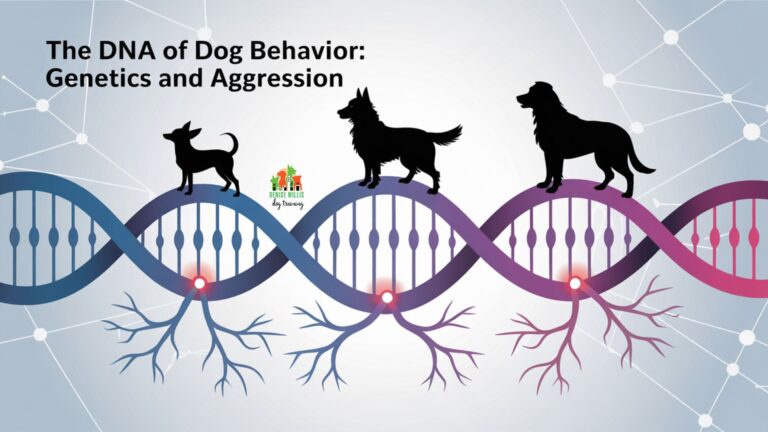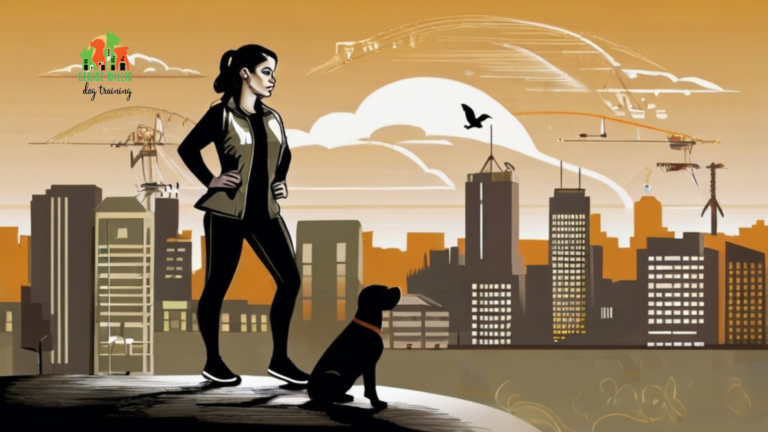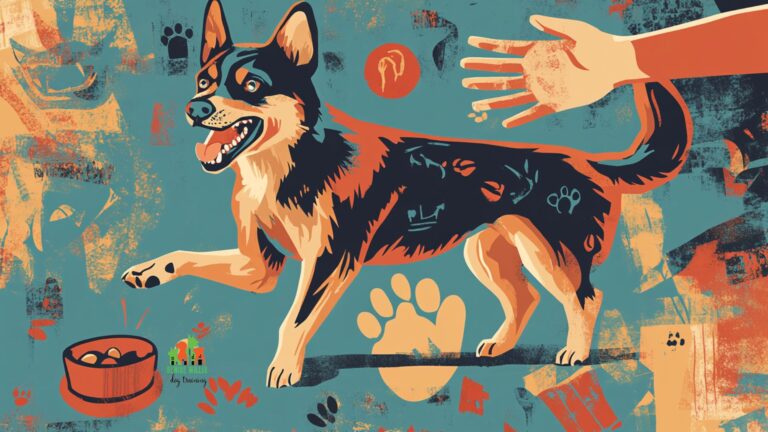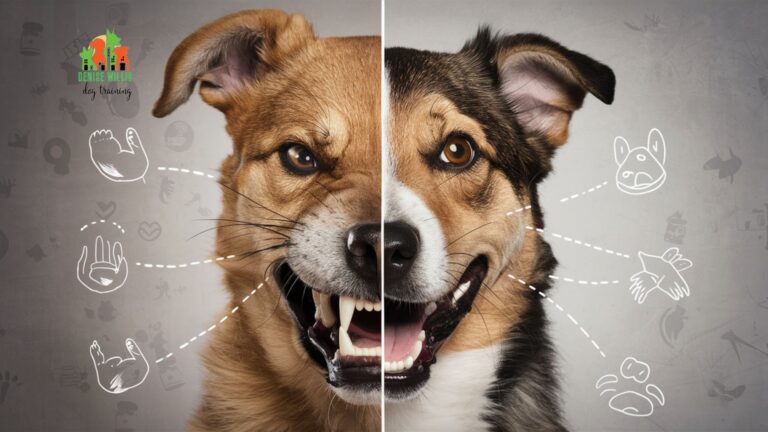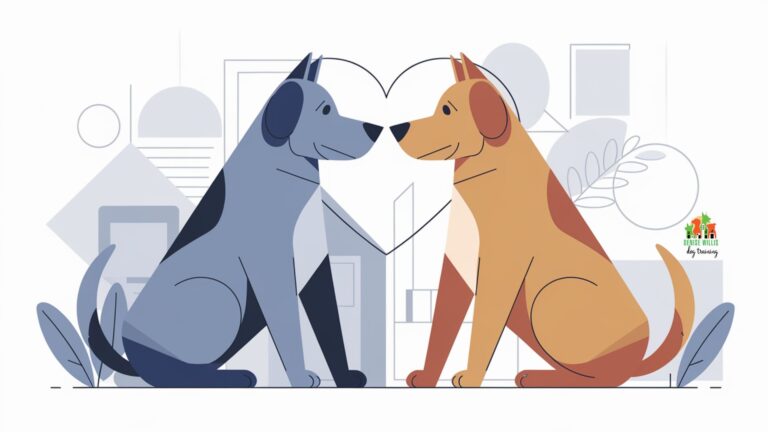Mine, All Mine! How to Stop Possessive Aggression in Dogs
📍 Service Area Notice: DW Dog Training provides in-person training services exclusively in the Greater Baltimore area. While our blog content is designed to help dog owners internationally, our hands-on training services are locally focused. For readers outside our service area, we hope you find value in our articles and welcome you to reach out with questions!
Picture your sweet, lovable pup suddenly transforming into a furry version of Gollum from Lord of the Rings, complete with growls and intense stares over their “precious” tennis ball. If this scenario hits close to home, you’re dealing with possessive aggression – a behavior that can turn even the most adorable pooch into a resource-hoarding champion.
While natural instincts drive dogs to protect valuable items, modern living requires our four-legged friends to share space, toys, and sometimes even their favorite humans without channeling their inner dragon.
Understanding and addressing possessive aggression in dogs demands patience, consistency, and sometimes a complete rethink of how we interact with our dogs.
That squeaky toy standoff in your living room?
It’s not about dominance or your dog plotting to overthrow the household hierarchy. Instead, think of it as your pup’s misguided attempt at financial planning. They’re trying to secure what they consider valuable assets, just with more teeth and less compound interest.
Resource guarding behavior can range from subtle body stiffening to full-blown aggressive displays.
The good news?
With proper training and management, most dogs can learn to loosen their grip on guarded items and develop healthier relationships with both their possessions and their humans.
Key Takeaways
- Safety comes first – never force a confrontation over guarded items
- Prevention through early training beats correction every time
- Professional help isn’t admitting defeat; it’s smart pet parenting
- Consistency matters more than quick fixes
- Management strategies work while training takes hold
Understanding Dog Possessive Aggression
Warning Signs
Watch for stiffening, whale eyes, freezing, growling, and lip curling when approaching guarded items.
Prevention
Use positive reinforcement, trading games, and early intervention to prevent resource guarding behaviors.
Training Solutions
Focus on counter-conditioning and positive reinforcement to change emotional responses to triggers.
Management
Create safe spaces, establish routines, and control access to high-value items during training.
Understanding Your Dog’s Mind
Getting inside your dog’s head might seem like a task better suited for a canine psychic, but understanding the motivation behind possessive aggression is crucial for addressing it effectively. Dogs don’t wake up one morning deciding to become resource guarders – this behavior develops from a complex mix of instinct, experience, and sometimes, our own unintentional reinforcement of their fears. By peeling back the layers of what drives this behavior, we can develop more effective and compassionate solutions.
Facts vs Fiction
Remember that friend who insisted dogs only guard stuff to prove they’re the “alpha”? Time to update that mental software. Modern behavioral science has thoroughly debunked the dominance myth, revealing that possessive aggression typically stems from insecurity and fear, not a canine power play.
Your dog isn’t channeling their inner dictator when they guard that half-empty food bowl or ratty old sock. They’re more like that anxious friend who never learned to share their french fries – convinced that once something’s gone, it’s gone forever. This perspective shift matters because understanding the true motivation behind the behavior shapes how we address it.
Warning Signs and Progression
Before we dive into the warning signs, it’s essential to understand that dogs communicate their discomfort in a sophisticated sequence of escalating signals. Think of it as their version of a traffic light system, where they start with gentle yellow warnings before moving to red alert. Recognizing these early signals can prevent situations from escalating and create opportunities for positive intervention.
Dogs rarely go from zero to snapping without warning. They’re actually quite polite about expressing their discomfort, starting with subtle signals that often go unnoticed by human observers. Think of it as a canine version of progressive warnings:
Level 1: The Side-Eye
- Body stiffening
- Whale eye (showing whites of eyes)
- Freezing in place
Level 2: The Clear Objection
- Low growling
- Lip curling
- Air snapping
Level 3: The Final Warning
- Lunging
- Snapping
- Biting
Learning to read these signals isn’t just about avoiding bites – it’s about recognizing when your dog feels threatened enough to resort to aggressive displays. This understanding forms the foundation for successful intervention and training.
Understanding the Numbers
If you’re wondering whether your dog’s possessive tendencies put you in a lonely boat on a vast ocean of perfectly behaved pooches, prepare to be relieved (or at least, to have company in your misery). Let’s dive into some eye-opening statistics that might make you feel better about your furry resource hoarder – or at least convince you that you’re not the only one negotiating with a four-legged treasure guardian.
| Behavior Type | Percentage | Notes | Source |
|---|---|---|---|
| Resource Guarding in Adult Dogs | 20% | Adult dogs showing some form of resource guarding behavior | [1] |
| Food Aggression | 27% | Dogs showing aggression around food bowls or treats | [2] |
| Object Guarding | 15% | Dogs displaying aggression over toys or other objects | [3] |
| Success Rate After Training | 85% | Dogs showing improvement after professional behavior modification | [4] |
| Early Prevention Success | 92% | Puppies responding to early prevention training | [5] |
Don’t let these numbers send you into a tailspin of despair or have you considering a career change to professional dog psychologist. The silver lining here is crystal clear. With proper training and early intervention, most dogs can learn to loosen their iron grip on resources. That 85% success rate after training isn’t just a number; it’s a beacon of hope for anyone currently tiptoeing around their dog’s favorite chew toy. And if you’ve got a puppy? That 92% early prevention success rate is practically screaming
“Start now!” (though maybe don’t actually scream it, as that might startle the puppy).
Prevention Strategies
Preventing possessive aggression is like investing in a retirement fund – the earlier you start, the better your returns. Whether you’re working with a puppy or an adult dog, establishing clear boundaries and positive associations around resources can prevent or minimize guarding behaviors. Smart management combined with consistent training creates an environment where your dog feels secure rather than threatened about their possessions.
Early Intervention
Starting from day one with a new puppy or rescue dog can make all the difference in preventing resource guarding. Just as you wouldn’t expect a toddler to understand sharing without guidance, dogs need to learn that giving up items leads to positive outcomes. This learning period is crucial for developing lifelong habits and confidence around resources.
Puppies enter their critical socialization period between 3-16 weeks of age, making this the perfect window for preventing possessive tendencies. During this time, they’re like little sponges, absorbing lessons about what’s safe and what’s threatening in their environment. Creating positive associations around humans approaching their food, toys, and resting spots can prevent future guarding behaviors.
Consider these foundational training exercises:
- Hand-feeding portions of meals
- Gentle trade-up games with toys
- Reward-based “drop it” training
- Multiple short training sessions throughout the day
Environmental Management
Think of environmental management as setting up your dog’s world for success rather than failure. Just as you wouldn’t leave chocolate bars scattered around a preschool, managing your dog’s environment means controlling access to items that might trigger guarding while you work on training. This approach reduces stress for both you and your dog while building new, healthier habits.
Strategic management includes:
- Removing high-value items when not directly supervised
- Using baby gates to create safe spaces
- Establishing consistent feeding routines
- Providing multiple water bowls in multi-dog households
- Creating designated rest areas for each dog
Multi-Dog Dynamics
Managing possessive aggression gets exponentially more complicated when you add more dogs to the mix. It’s like juggling flaming torches – possible with practice, but requiring careful attention and precise timing. Understanding how dogs interact around resources and establishing clear protocols can prevent tension and potential conflicts.
Managing Multiple Dogs
Living with multiple dogs requires a delicate balance of structure and flexibility. Like siblings sharing a bedroom, dogs need their own space and belongings while learning to coexist peacefully. Creating clear boundaries and routines helps prevent resource-related conflicts and reduces stress for all pack members.
Core management strategies include:
- Separate feeding areas and schedules
- Individual training sessions
- Rotating access to high-value toys
- Supervised group interactions
- Clear boundaries for resting spaces
Dog-to-Dog Guarding
Before diving into specific techniques, it’s important to understand that dog-to-dog resource guarding often requires a different approach than guarding directed at humans. Dogs naturally establish their own social rules around resources, but these rules need to be managed to prevent dangerous escalations.
Key prevention steps include:
- Never force dogs to share high-value items
- Provide enough resources to prevent competition
- Monitor body language during interactions
- Intervene before tensions escalate
- Reward calm, sharing behaviors
Timeline for Addressing Possessive Aggression in Dogs
Early Prevention (0-12 weeks)
- Birth to 2 Weeks: Gentle handling by humans and initial positive contact
- 2-4 Weeks: Natural socialization with littermates
- 3-12 Weeks: Critical socialization period with positive human interactions
- Introduction to bite inhibition learning through play
Early Development (3-8 months)
- Establishment of basic training and structure
- Management of independence and willfulness
- Focus on consistent training reinforcement
- Handling potential regression in training
Adolescence (6-14 months)
- Careful management of new situations during second fear period
- Monitoring for increased reactivity
- Avoiding traumatic experiences
- Continued reinforcement of training
Young Adulthood (18-24 months)
- Management of protective behaviors
- Reinforcement of previous training
- Addressing territorial tendencies
- Establishing long-term behavior patterns
Treatment for Existing Issues
- Environmental management
- Identification of triggers
- Basic training establishment
- Implementation of desensitization
- Counter-conditioning exercises
- Trade-up games practice
- Ongoing maintenance training
- Regular socialization practice
- Professional support as needed
Modern Training Solutions
Gone are the days of alpha rolls and dominance-based training methods. Modern approaches to possessive aggression focus on changing your dog’s emotional response to having their resources approached. Think of it as teaching your dog that sharing isn’t just caring – it’s actually rewarding. Through consistent positive reinforcement and strategic training, even dedicated resource guarders can learn new, more appropriate behaviors.
Positive Reinforcement Techniques
Before diving into specific exercises, it’s crucial to understand that positive reinforcement isn’t just about treating good behavior. It’s about creating a new association with situations that previously triggered guarding. This approach transforms the presence of humans near valued resources from a threat into an opportunity for something even better.
Start with these foundation exercises:
- Trading low-value items for high-value treats
- Adding special treats to food bowls during meals
- Rewarding calm behavior around resources
- Teaching “leave it” with increasing distractions
- Practicing “drop it” with multiple toy options
Counter-Conditioning
Counter-conditioning might sound like a fancy term for laundry day, but it’s actually about changing your dog’s emotional response to triggers. This process requires patience, precise timing, and a solid understanding of your dog’s threshold – that sweet spot between awareness and reaction where learning can occur.
The process typically follows these stages:
- Identifying individual triggers
- Establishing safe working distances
- Gradual exposure to triggers
- Pairing triggers with positive experiences
- Slowly decreasing distance to triggers
Special Situations
Every dog and household presents unique challenges when dealing with possessive aggression. Like a custom-tailored suit, training approaches often need adjustments to fit specific situations perfectly. Understanding these special circumstances helps create more effective, targeted solutions for your particular case.
Working with Children
Children and dogs can be a wonderful combination, but when possessive aggression enters the picture, safety must become the top priority. Before implementing any training programs, it’s essential to establish strict guidelines for interactions and ensure all family members understand the importance of following these rules.
Essential safety protocols include:
- Never allowing children to approach a dog with food or toys
- Teaching children to respect dog’s space
- Supervising all interactions
- Creating safe zones for both dogs and kids
- Implementing clear rules for everyone
Senior Dogs
Working with senior dogs who develop possessive aggression requires special consideration. Like humans, older dogs might become more protective of their resources due to physical discomfort, decreased mobility, or cognitive changes. Understanding these age-related factors helps create more effective and compassionate training approaches.
Consider these factors when working with senior dogs:
- Regular veterinary check-ups
- Modified exercise routines
- Adjusted training sessions
- Pain management if needed
- Environmental modifications
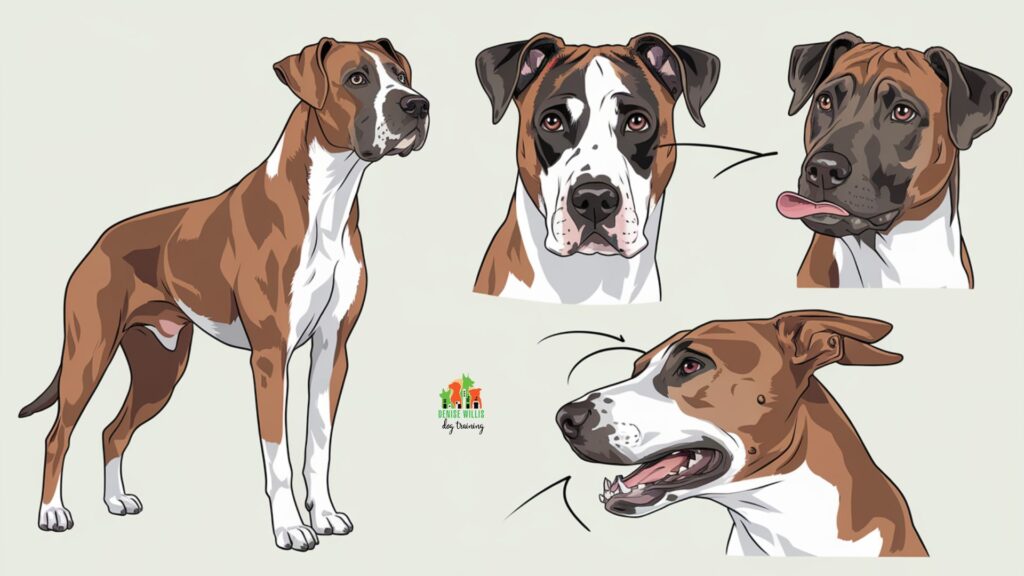
Professional Support
Like calling a plumber for a major leak instead of watching DIY videos while your basement floods, knowing when to seek professional help with possessive aggression can save you time, stress, and potential injuries. Professional dog trainers and behaviorists bring experience, objective assessment skills, and proven protocols to address serious resource guarding behaviors.
When to Seek Help
Perhaps you’ve tried the basics, watched countless training videos, and still find yourself tiptoeing around your dog’s treasured possessions. Recognizing when you need professional intervention isn’t admitting defeat – it’s making a smart choice for both you and your dog’s safety and success.
Red flags that signal time for professional help:
- Multiple biting incidents
- Aggression around children
- Failed attempts at basic training
- Escalating behavior
- Resource guarding multiple items or spaces
- Signs of stress in other family members
Working Together Effectively
Before jumping into training schedules and behavior modifications, understanding how to maximize your professional training experience can make the difference between success and frustration. Think of it as a partnership – the trainer provides expertise and guidance, but your consistent follow-through at home creates lasting change.
Keys to successful professional partnerships:
- Clear communication about goals
- Honest reporting of incidents
- Consistent application of protocols
- Regular progress updates
- Commitment to recommended changes
Recovery Journey
The path to recovery from possessive aggression isn’t a sprint – it’s more like a cross-country trek with occasional detours and rest stops. Understanding what to expect along the way helps maintain motivation and recognize progress, even when it feels slow.
Setting Expectations
Like any significant behavioral change, overcoming possessive aggression takes time, consistency, and realistic goal-setting. Success rarely looks like a straight line upward; instead, expect a series of improvements punctuated by occasional setbacks.
Measuring progress markers:
- Decreased intensity of reactions
- Longer threshold distances
- Willing participation in training
- Improved response to commands
- Relaxed body language around resources
Product Recommendations
Shopping for a resource-guarding pup is like preparing for a tiny dragon protecting their treasure hoard. But fear not!
We’ve assembled a collection of tools that would make even Smaug reconsider his hoarding habits. Here’s your arsenal for transforming your possessive pooch into a sharing superstar:
- PetSafe Gentle Leader Headcollar: Transform your resource guardian into a perfect gentleman with this head halter. It’s like power steering for your dog, giving you gentle control without the drama. Warning: Your dog may temporarily think they’ve joined a secret society of sophisticated canines who wear fancy face accessories.
- KONG Classic Dog Toy: The Fort Knox of dog toys, perfect for redirecting those guarding instincts. Made from ultra-durable natural rubber, it’s like a chew toy and puzzle feeder had a super-strong baby. Caution: May cause your dog to expect all their meals served in rubber form.
- Outward Hound Nina Ottosson Dog Worker: Turn mealtime into brain time with this interactive puzzle feeder. It’s like “Mission Impossible” for dogs, minus Tom Cruise’s running scenes. Warning: Your dog may become so good at puzzles they start doing your crosswords.
- ThunderShirt Classic Dog Anxiety Jacket: Help your tense treasure-guarder feel more secure with this snug anxiety wrap. Like a constant hug from a very patient friend who doesn’t mind dog hair. Caution: May cause excessive relaxation and impromptu naps.
- Zuke’s Mini Naturals Training Treats: Tiny, healthy treats perfect for reward-based training. These little morsels are like doggy currency – small enough for frequent rewards but tasty enough to make sharing worthwhile. Warning: Your dog may start expecting payment for every good deed.
Remember, while these products won’t turn your resource guarder into a sharing saint overnight, they’ll make the journey more manageable (and way more fun)!
Further Reading
Ready to become a certified expert in canine psychology? These articles will take you deeper into the fascinating world of dog behavior. Just remember: knowledge is power, especially when that power comes with tail wags!
- 10 Simple Steps to Prevent Resource Guarding in Puppies: Start your puppy off right! This guide helps you nip guarding behaviors in the bud before your little fur ball decides the entire house is their personal vault.
- Decoding Your Dog: 15 Body Language Signals You Need to Know: Learn to read your dog like a book – a very furry, occasionally drooling book. Spoiler alert: The tail isn’t the only thing doing the talking!
- Dog-to-Dog Resource Guarding: Because sharing is even harder when everyone has four legs and a tail. Master the art of keeping peace in your multi-dog household.
- 5 Simple Hacks to Stop Your Dog’s Resource Guarding: Quick, effective solutions for when your pup thinks they’re the CEO of Toy Corporation. Warning: Results may vary, but the techniques are solid gold.
- Dog Aggression Solutions: A Complete Guide to Stopping Aggressive Behavior in Dogs: The ultimate handbook for understanding and addressing all forms of canine aggression. It’s like getting a Ph.D. in dog behavior, minus the student loans.
Don’t stop now.
Your journey to becoming a resource guarding guru is just beginning! These articles are packed with more wisdom than a tennis ball has bounce. Dive in and discover how to help your furry friend share their treasures with a happy heart.
Frequently Asked Questions About Possessive Aggression in Dogs
Q: How do you fix possessive aggression in dogs?
A: Success comes through a combination of management, positive reinforcement, and counter-conditioning. Start by trading up – offering something more valuable than what your dog guards. Never forcefully take items; instead, teach “drop it” using high-value rewards. Professional help may be necessary for severe cases.
Q: What does possessive aggression look like in dogs?
A: Watch for stiffening body posture, staring, standing over items, growling, snarling, snapping, or biting when approaching their possessions. These behaviors can appear in any breed or gender and may start subtly before escalating.
Q: Why is my dog suddenly aggressive and possessive?
A: Sudden changes in behavior warrant veterinary attention first to rule out medical conditions. Environmental stressors, changes in routine, or lack of proper training can trigger possessive aggression. Identifying the root cause helps determine the most effective treatment approach.
Q: How do I get my dog to stop being possessive of me?
A: Address possessive behavior around people through structured training and reward-based methods. Ignore attention-seeking behaviors and reward calm, appropriate interactions. Professional guidance can help create specific protocols for your situation.
Test Your Knowledge: Possessive Aggression in Dogs
Final Thoughts
The journey from resource guarder to reformed sharer might feel daunting, but remember every successful training journey starts with a single treat trade. Through patience, consistency, and appropriate professional support when needed, most dogs can learn to relax their iron grip on resources.
Your Next Steps
Ready to start transforming your little resource hoarder?
Begin with simple management strategies while building your training plan. Remember that safety comes first. If you're unsure about handling any aggressive behaviors, DW Dog Training can provide the guidance and support needed for successful rehabilitation.
Share Your Experiences
Every dog's journey through possessive aggression is unique.
Share your experiences, challenges, and successes in the comments below. Your story might provide valuable insights or encouragement for others facing similar challenges with their furry friends.

